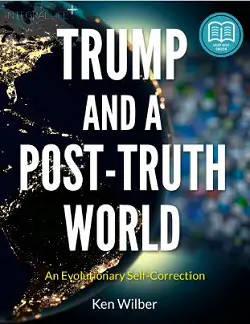|
TRANSLATE THIS ARTICLE
Integral World: Exploring Theories of Everything
An independent forum for a critical discussion of the integral philosophy of Ken Wilber
 David Christopher Lane, Ph.D.
Professor of Philosophy, Mt. San Antonio College Lecturer in Religious Studies, California State University, Long Beach Author of Exposing Cults: When the Skeptical Mind Confronts the Mystical (New York and London: Garland Publishers, 1994) and The Radhasoami Tradition: A Critical History of Guru Succession (New York and London: Garland Publishers, 1992). David Christopher Lane, Ph.D.
Professor of Philosophy, Mt. San Antonio College Lecturer in Religious Studies, California State University, Long Beach Author of Exposing Cults: When the Skeptical Mind Confronts the Mystical (New York and London: Garland Publishers, 1994) and The Radhasoami Tradition: A Critical History of Guru Succession (New York and London: Garland Publishers, 1992).SEE MORE ESSAYS WRITTEN BY DAVID LANE The Missing NuanceKen Wilber and Integral PoliticsA Four-Part Critique, Part OneDavid Lane
Early in his e-book Wilber reveals what Professor Bennett Berger would call his “metaphysical pathos”.
There is much to commend in Ken Wilber's latest e-book, Trump and a Post-Truth World, since it attempts to incorporate a much wider perspective on how and why Donald Trump has been so successful in securing the Presidency of the United States. Wilber clearly has thought deeply about this subject and offers a tantalizing array of observations—historical and otherwise—to enlighten his readers about how Integral thinking can better appraise our current political climate. However, as much as I appreciate Wilber's efforts here, I find that his argument devolves too often into undocumented generalities and cheap color-coded reductionisms that because they lack the necessary nuance weaken the overall thrust of his presentation. In the following essay I will underline where I think Wilber's framework needs shoring up. I thought it might be wise to quote Wilber directly and then explain what I find questionable.
Every now and then, evolution itself has to adjust course, in light of new information on how its path is unfolding, and it starts (apparently spontaneously but with this deeper morphic field actually operating) by making various moves that are, in effect, self-correcting evolutionary realignments. (p. 4)
And a few pages later he adds,
“(Evolutionary biologists in general tend to deny any sort of directedness or telic drives to evolution, seeing all of it as a random series of events selected by a blind natural selection. But this is just a holdover from the reductionistic scientifc materialism of the 19th century. It overlooks more current scientific concepts that, starting with Ilya Prigogine's Nobel-Prizewinning discoveries, even insentient material systems have an inherent drive to self-organization. When physical systems get pushed “far from equilibrium,” they escape this chaos by leaping into a higher-level state of organized order—as when water that is chaotically rushing down the drain suddenly leaps into a perfect downward swirling whirlpool—referred to simply as “order out of chaos.” If nonliving matter inherently possesses this drive to self-organization and order out of chaos, living systems certainly do—and that defnitely includes evolution—a drive that philosophers often call “Eros,” an inherent dynamic toward greater and greater wholeness, unity, complexity, and consciousness.” (p. 9)
Early in his e-book Wilber reveals what Professor Bennett Berger would call his “metaphysical pathos”, which is that evolution has a purpose and a direction. Wilber also indulges in a very questionable reification when he suggests that “evolution itself has to adjust course” as if evolution was conscious of its long-term goals. Yet, as Douglas Futuyma clearly points out in his textbook, Evolution, “[Darwin's] alternative to intelligent design was design by the completely mindless process of natural selection, according to which organisms possessing variations that enhance survival or reproduction replace those less suitably endowed, which therefore survive or reproduce in lesser degree. This process cannot have a goal, any more than erosion has the goal of forming canyons, for the future cannot cause material events in the present. Thus the concepts of goals or purposes have no place in biology (or any other of the natural sciences), except in studies of human behavior.”[1] Wilber, in contrast to most working biologists in the field, wants evolution to be conscious and clear eyed with an end goal in mind. I realize he may want to believe this, but if so he is indulging in theology not biology. Even Ilya Prigogine wouldn't agree with Wilber's assessment that evolution has a Teilhard de Chardin like directional aim, since the deceased physical chemist argues “Chardin described the world as if he were outside of it. He was sure that every change, every new bifurcation, was going in the right direction — in the direction of increased spirituality. On the contrary, I am more impressed by the existence of multiple time horizons. A bifurcation can lead us to the best or to the worst. We are participating in an evolution whose outcome isn't clear to us. So I leave open the question of the meaning of being. I'm not even certain whether, put in these terms, a scientific answer is possible. Probably it has more to do with feelings or emotions.”[2] Eros isn't a scientific concept as much as a god-laden one in order to provide evolution with an overarching drive. Yes, one can believe it, just as one can believe that Atlas is holding up the earth on his back, but that doesn't make it testable or even reasonable, especially given the almost absolute indifference the known universe has to sustaining life. And even here we are talking about life forms that live for very short intervals in utterly brutal conditions and survive only by munching on their edible neighbors. If anything, the planet earth looks like a prolonged horror movie where everyone ends up being tortured to some extent before succumbing inevitably to death. As such, therefore, Wilber is providing us with his own religious views dressed up in scientific garb, but without providing us with all the requisite information. Alleges Wilber,
“The leading-edge of cultural evolution is today—and has been for four or five decades—the green wave (“green” meaning the basic stage of human development known to various developmental models as pluralistic, postmodern, relativistic, individualistic, beginning self-actualization, human-bond, multicultural, etc.—and generically referred to as “postmodern”). The primary purpose of the leading-edge of evolution is to be just that: a LEADING edge of evolutionary unfolding, what Maslow called a “growing tip”—it seeks out (that is, part of its selection context rewards the discovery of) areas that are the most appropriate, most complex, most inclusive, and most conscious forms that are possible at that particular time and point of evolution (in Integral terms, the form that best fits the ongoing unfolding of the AQAL matrix in all its elements). (p. 4)
Here Wilber even gives evolution a prime directive—what he calls “the primary purpose”—which is always to push the envelope for the next stage in the great chain of being to unfold. If, however, we don't accept Wilber's creation myth (because that is precisely what it is), then his entire Integral edifice comes crashing down, since his political argument is built piece by piece upon this rather tenuous foundation. And upon this scaffolding model, Wilber then tries to build his argument about our current political situation by using (as his habit) voodoo statistics and reductive color-coding in order to make sweeping generalizations so as to drive home his thesis. Yet, in doing such, he neglects (as usual) the very facts and numbers that would give one pause. Watch carefully how Wilber invokes statistics without providing us with the necessary references or context to properly appreciate whether they really substantiate his purview.
Beginning in the 1960s, green began to emerge as a major cultural force and soon bypassed orange (which was the previous leading-edge stage, known in various models as modern, rational, reason, formal operational, achievement, accomplishment, merit, profit, progress, conscientious) as the dominant leading-edge. It started with a series of by-and-large healthy and very appropriate (and evolutionarily positive) forms—the massive civil rights movement, the worldwide environmental movement, the rise of personal and professional feminism, anti-hate crime, a heightened sensitivity to any and all forms of social oppression of virtually any minority, and—centrally—the understanding of the crucial role of “context” in any knowledge claims and the desire to be as “inclusive” as possible. The entire revolution of the sixties was driven primarily by this stage of development (in 1959, 3 percent of the population was at green; in 1979, close to 20 percent of the population was)—and these events truly changed the world irrevocably.” (p. 4)
First, and most importantly, how does anyone, much less Wilber, know that in 1959 3 percent of the population was green? Or, how do we know that in 1979 that percentage grew to nearly 20 percent? Who checked the random sampling errors or biases at this time? Who designed the questionnaire? How was the random sample drawn? Which countries were involved in the survey? Unless Wilber is willing to do some real work in this area, invoking statistics like these is just another form of sociological hocus-pocus. And instead of actually engaging in a reasoned and refined argument about different stages in societal consciousness, Wilber resorts to his over-used schematic of color-coding, which as I have pointed out previously is a cheap form of New Age reductionism. Human beings are not monochromatic and any theory that resorts to such labeling is intellectually lazy. Wilber interweaves his voodoo statistics throughout his e-book, and just a few pages later lamenting the post-modern worldview which he believes has taken over academia suggests that
“Right now, only about 5 percent of the population is at any of these integral stages, but the evidence is that this is clearly where tomorrow's evolution eventually will go—if it can survive the present transition.)” (p. 7)
Huh? How can Wilber with a straight face say “5 percent of the population”? Where does this number come? Has anyone done a survey of the entire 7 billion people on terra firma to find out “how” Integral they are? Using numbers like this in such a haphazard and imprecise fashion is dishonest and (the pun is revealing) lacking in integrity. NOTES[1] Douglas J. Futuyma, Evolution, Second edition, Sinauer Associates, Inc, 2009. Chapter 11: "Natural Selection and Adaptation". [2] Robert B. Tucker, "Ilya Prigogine on the Arrow of Time", omnimagazine.com (OMNI Q&A Archives), © 1983.
|

